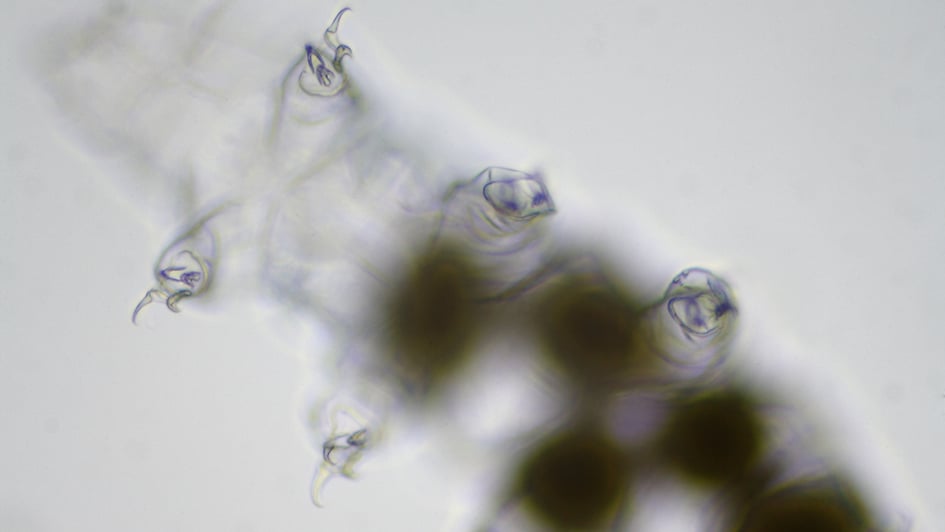
Microscopic view from underneath a tardigrade. Credit: Specious Reasons CC BY-NC-SA 2.0
Despite huge progress in cancer genetics and biology and significant advances in diagnosis and treatment, the harsh reality is that prospects for patients presenting with advanced or metastatic disease often remain stubbornly dismal.
Radiotherapy, drugs, immunotherapy or combinations thereof tantalisingly provide a temporary reprieve only for the disease to return, phoenix-like, with a vengeance.
The fundamental problem is no longer a mystery. Advanced cancers are genetically unstable and diverse. And having negotiated many built-in restraints to reach that stage, they are robust to challenge. With billions of cells on board, resistance is intrinsic or inevitable and, paradoxically, positively selected by treatment.
Why are we still surprised by this? The cancer clone in a patient may be only a few years old but the cells have inherited a four billion year legacy that provides them with traits, genetic and epigenetic, that can be co-opted to enable survival from assault.
Evolution may, as Richard Dawkins asserts, be just a story about reproduction. But if you don’t survive, mating, or just dividing in two, is not on the menu. And the board on which the game of life is played is replete with parasites, predators and habitat traps that favour survival traits.
Evolutionary resilience
Evolution is also a numbers and diversity game. Consider the five or more times planet Earth has suffered a major extinction event. Dramatic climate changes have brought havoc with up to 95% of species decimated. But evolutionary resilience always wins out.
Somewhere there will be individuals that by behaviour, phenotype or luck survive. Not only survive but emerge from the deluge to flourish. We probably owe our existence, as a mammalian species, to one such catastrophe that eliminated the voracious dinosaurs 67 million years ago.
And, not surprisingly, some variants or species are much tougher and equipped for survival than others, reflecting ancestral challenges. Consider the tardigrade. The what?
Tardigrades, water bears or moss piglets, are small (~1 mm) arthropod-like creatures that you can find hiding in moss in your garden. They win no beauty contest but just try killing them. They can be frozen, boiled or dehydrated and withstand massive pressures. They have been blasted into space. They survive radiation – 100 times the lethal dose for other species and cells.
You could well retort, OK but you’re talking about the ability of whole organisms to survive, not cells. Well, for two billion years, there was nothing but single cells and, even now, they account for 90% of most of life’s diversity. They’ve had plenty of time to adopt a whole bag of survival tricks.
Donate towards the Centre for Evolution and Cancer to help fund the brightest minds in the field to set up new research teams, and to provide studentships and fellowships for the development of new talent.
Read more
Trying to cure advanced cancer
More significantly for us is what happened when multi-cellularity was ‘invented’ around 700 million years ago. Fitness to survive was then a feature of the whole animal (or plant). But some types of cells, and especially stem cells, which were in limited supply and essential for life, retained the multiple talents required to survive lethal challenge.
Our stem cells do this by phenotypic plasticity and by adopting a dormant or quiescent lifestyle in niches. Moreover, they pump out noxious compounds, including drugs, via very active efflux pumps. And our cancer stem cells, in effect, are pulling out all the stops and returning, in an atavistic fashion, to a selfish, unicellular lifestyle for which they have a long evolutionary memory.
So when we attempt to eradicate advanced and diverse cancers, it really should be no surprise that tardigrade-like propensities come to the fore. Trying to cure advanced cancer by eliminating all cancer cells is trying to outsmart four billion years of evolution that has empowered resilience.
The success of targeted therapy
Now, I hear someone saying: but Professor Greaves, don’t you work on the leukaemias? And doesn’t success in curing them contradict your argument? Childhood acute lymphoblastic leukaemia (ALL) now enjoys a cure rate of around 90% with combination chemotherapy. And what about the striking success of targeted therapy with small-molecule kinase inhibitors in chronic myeloid leukaemia (CML)?
I’m afraid those undoubted successes prove my point. ALL, as well as testicular cancer and choriocarcinoma, are lethal without treatment but now over 90% curable. The reason, or a big part of it, is that these cancers arise from very drug-sensitive cells, disseminate early in their evolutionary trajectories and are minimally diverse, genetically.
CML is a pre-malignant condition and the very effective drugs used – imatinib and similar tyrosine kinase inhibitors – target the founder lesion in genetically quiet cells. This is very different from advanced, common cancers. Killing a butterfly, not a tardigrade.
So what to do? How to kill tardigrade-like cells? A cocktail or double whammy of drugs plus radiation? Drugs plus immunotherapy? I doubt it. More finesse or subterfuge is called for. Any offers?
comments powered by